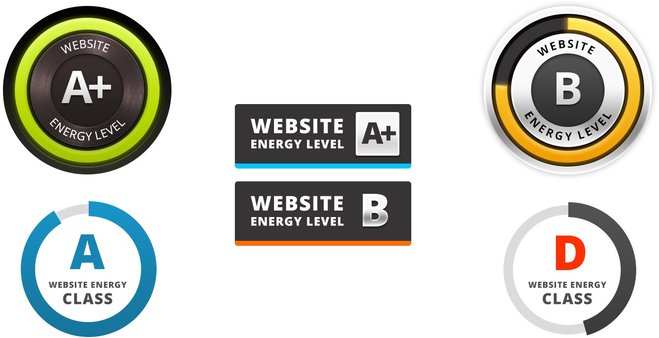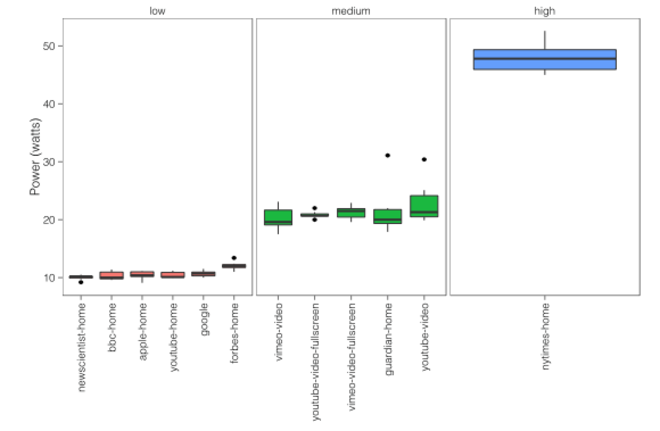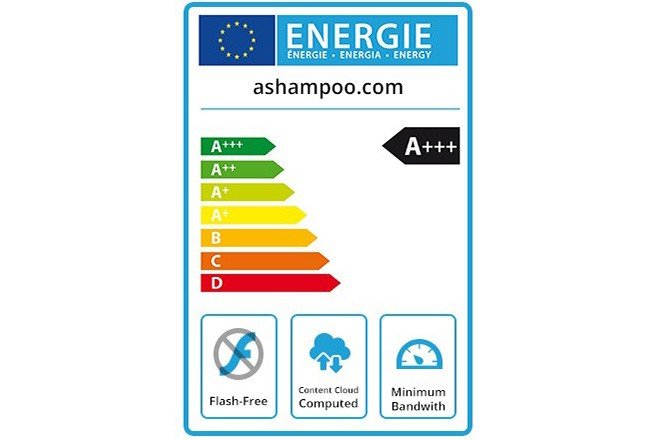Did you know different websites consume different amounts of power? Neither did I.
For years, one topic has been in the focus of the world: How do we reduce our enormous energy footprint in favor of our environment? The dynamics of this global issue has brought about an energy revolution with many recent useful discoveries - solar fields, electric cars and wind turbines, the latter of which can be easily spotted rising into mostly rainy skies here in the northern part of Germany by the dozen. But that's another story.

To protect our globe and, naturally, our health there have been an unending number of regulations, laws and labels. But the moving "spotlight" of science or the industry has not yet touched every aspect of our lives. Little by little, we analyze the world always looking for power hogs. But maybe some of these can be found in areas we never thought to look.
When I heard of a test that proves different websites consume different amounts of energy on your PC, that was totally new to me. But then, the testers noticed that the subject (in this case a laptop computer) spun up its cooling fan with some pages but not with others. The first clue. Consequently, this raises the question why we put energy labels on our cars and fridges but not on websites. But first things first.
The setup
So, some websites are more power hungry than others. Based on this assumption, the testers first created a stringent laboratory setting. The laptop was set at 50% brightness throughout the test. All applications were closed, backup mechanisms disabled and the battery was at 100%. Measuring commenced 10-30 seconds after each website request.
The scientists found the following results:

(Source: http://santtu.iki.fi) x-Axis:websites from 3 categories ; Y-Axis: energy in watts. From left to right: New Scientist, BBC, Apple, YouTube, Google, Vimeo Video, YouTube video in fullscreen mode, Vimeo video in fullscreen mode, The Guardian, YouTube video, The New York Times.
How do we interpret these results?
What's striking at first is that video-heavy sites such as Vimeo or YouTube consume little more energy than text- or image-only sites. But there is a noticeable difference in power consumption across different websites. The most intriguing finding is the outlier, i.e. The New York Times, which drew the most power. Since this was a random selection it is safe to assume that there are other power hogs on the WWW.
Conclusion:
As stated initially, we label our products based on power consumption and that is the smart thing to do as it causes manufacturers to either improve their products or see them fade from the market. Take fridges, for example, that are labeled from A to A+++ with the difference amounting to as much as 33 kW h. Multiplied by the number of EU households this would mean energy savings of 790 megawatts if every household used A+++ devices exclusively.
Let's apply this to the WWW: Assuming that 30% of the world's population spend an hour on the Internet each day, a difference of only 10 watts will amount to a total of 875 megawatts. This assumption isn't far-fetched once you consider that The New York Times consumes 20-30 watts more than Vimeo or YouTube.

Taking all things into consideration, it is reasonable to call for website labels or at least discuss the issue. Mankind is trying to optimize power consumption for various areas. Why not include the WWW? Let's imagine for a moment that Google picked up on this idea and adjusted their rating system to accommodate for power consumption. Google applies a similar approach for other aspects. Loading times and responsiveness, e.g. on cellphones and tablets, already affects website ratings.
Dear Google, please take a closer look at the above test. We think the idea of weeding out overly power-hungry websites is worth considering. Since we are aware that you are always under a 100% workload we have taken the liberty to design a suitable label that helps Internet users tell the energy-efficient sites from the power hogs. We'll gladly let you have it for free to support a good cause!
Author's note: Manager’s Corner is a cooperation between Ashampoo CEO Sebastian Schwarz and Jan-Gerrit Dickebohm




Sounds good, but how would it look if it was rated by the # of inter-actable items available per web site. Maybe the NY Times would win hands down!
On the other hand what would your test have looked like if you had done it on an Ipad and then on a whizbang super computer? Maybe we should all use tablets or smaller!
Or perhaps a return to electric typewriters, telephones and faxes is the answer!
What an excellent idea. Many households now purchase the least energy hungry equipment aware that so doing reduces household energy consumption. Being aware of energy consumption of a SITE would almost certainly have the same effect on computer usage and may persuade the most greedy sites to change their approach.
На счёт энергии.... Сколько сгорает электричества от вашего компьютера не так важно! Если у вас солнечная батарея! Я как то глянул в Гугле на земной шар и просто был в шоке! Сколько в данный момент в воздухе самолётов ( один самолёт одна красная точка)? США вся была красная, потом Европа. Представьте сколько сжигает кислорода один самолёт? Это жизнь нескольких тысяч человек! Это мы ещё не можем подсчитать! Автотранспорт, пароходы итд. Скоро не нужно будет раздеваться! Вышел под кислотный дождь и вся одежда сползла! Когда то углекислота вытеснит кислород из нашей земной атмосферы... И жизнь прекратится!
I write 5 websites and am wondering how I can calculate their energy consumption...
Well I never! who would have thought , but when you do it makes perfect sense, the more stuff that has to be loaded on to the screen the harder the processor works ,the more heat is generated therefore the cooling fan on the laptop cuts in .yeh
Our enormous energy footprint will remain for many years until fossil fuels are depleted.
All the solar power in the world, wind turbines, electric-drive vehicles, other power-producing products and bicycles are a mere speck on the planet compared to fossil-fuel energy being produced, and fossil fuel energy to produce products to create 'green' energy.
Whenever I witness dozens so-called 'footy' games played at night under a mass of energy-guzzling lights producing a daylight effect, I doubt that players and followers even care about the disgustingly huge amount of energy being used, they should play the games in natural light, idiots.
They travel to the venues in cars and buses.
All the lectures, the meetings, the media reports, the attempted brainwashing of citizens to do their 'bit' to reduce fossil-fuel energy is not having much effect as the years go by........not many people give a damn, and I have been told that by many people, the response, "Who cares, we won't be here when the world ends."
all sounds good,let us hope that the lable system is adopted and give us the choice to decide to use the site or not.
keep up the good work.
Interesting to read the two comments so far and with respect to those two it demonstrates two areas of thinking, one somewhat detailed as to how, where etc and the other of 'no care'. i noticed the EU flag in the corner which is okay but through the WWW we are a global community so that needs to be remembered. The mention of an EU Directive and considered uptake by the rest of the world doesn't really need to be a consideration when the uptake and use of something like this could grow exponentially if adopted voluntarily by a major player like Google who in turn set the standard, approved the application and electronically policed. This way, or similar, there are no political or international boundaries and regulations to be considered and dealt with. The example given of say 850 MW use needs to be considered not just as a use figure but as a generation volume. To generate from the environment this ever growing need for energy if not from renewable sources like solar, wind and maybe others can have a long term devastating effect on the flora and fauna over a large area. The concern is already there as we see the world moving to more energy efficient consumer items, LED lighting, vehicles and more. Any effort whatsoever no matter how small to consume energy more efficiently needs to be considered as the world (population) continues to grow so will the consumption of energy grow. It's a matter of whether we have a moral conscience, each and every one of us in the international community, to consider the future for the next generation. It would be easy for someone like me who is very much in the twilight years to say let my grand children sort it out but that's not good enough. Finally I say it's not about regulations, exact figures, debating issues, legislative adoption, exact label design and so on, Yup, it is about riding a bicycle, which I would hope is not taken literally but means look to ways to consume less energy which means the adoption and use of more energy efficient products and the way they are used. Voluntary adoption in one way or another can become a global force.
Interesting treatise but it seems that it's a case of comparing 'Apples & Pears'.
Yup, and if we all rode bicycles..
While you are correct to point out that there is a potential for energy savings with better designed web sites, you have misinterpreted the meaning of the energy label and rating system.
Don't be alarmed; most people do not correctly understand the information on the energy label.
The predominant feature is the colour coded rating system, ranging anywhere from A+++ down to G. Contrary to popular belief this DOES NOT indicate the amount of energy consumed. The approximate energy consumed annually will in NUMBERS in a separate box (usually in kWh). The colour coded rating indicates EFFICIENCY i.e. how much of the energy (electric, gas etc.) is actually used to carry out the intended function of the product. so the product can use large amounts of energy and still be rated 'A' or above as long as the majority of the energy is not wasted. By the same token, the product can use very little energy but be rated 'B' or lower because it doesn't use all of the energy for it's primary function. For instance, A 55" TV consuming 300 Watts could be 'A' rated but a 15" TV consuming 50 Watts could be 'B' rated because the backlight is less efficient or the power supply is cheap and wasteful of power.
There is a complicated test and calculation process for determining the energy rating and energy consumption, a process which is different for each type of product, so the rating scale for washing machines is different to TVs etc. so you can't correlate between different products.
A prime example is electric showers. An electric shower can consume as much as 10500 Watts, but since most of that energy is used to heat water, it will come out as 'A' rated if it reaches usable temperature very quickly, but a lower power shower at 7500 Watts could be 'B' rated because it takes longer to heat up to usable temperature and so wastes more energy initially.
The key number you should look at on the energy label is the annual energy consumption, which is calculated on various assumptions such as how often the product is used and for how long.
As far as websites are concerned, the energy label you depict is only for use in the European union and requires EU directives and then implementing measures (regulations) to be developed, which then become integrated into legislation at a national level (takes years!). The internet is a global system and it would be impossible to get any consensus on how to implement such a scheme, much less how it could be enforced.
In any case, it is the PC that is consuming power, not the website, and this could vary, depending on the type of OS, browser being used and PC specification. The extreme difficulties in having a standardised method for calculating energy efficiency and consumption for PCs and laptops is the reason why these products do not currently have an energy label.
Apologies if this was intended as a light-hearted post, but hopefully you are now slightly better placed to correctly interpret the energy rating labels on products.
Many thanks for your insightful response! You live and learn!